College of Charleston Alums Take on the J/70 World
Published on April 15th, 2013
Charleston, SC (April 15, 2013) – Sperry Top-Sider Charleston Race Week (April 19-21) attracts a broad range of competitors, and they arrive from all over the U.S. and at least six foreign countries. Among the participants in this three-day competition you’ll find full-time professional racers, sailing industry experts and talented amateur sailors, along with those who are just getting a taste of serious sailing competition for the first time.
One of the most hotly contested groups among the 18 different classes that make up the event is apt to be the J/70 Class. With 56 boats registered, this will also be the largest class at the regatta. These 23-foot long speedsters were only introduced last year, but already they’ve gained tremendous market traction.
Within the J/70 Class will be an equally broad spectrum of competitors, with plenty of nationally renowned sailors scattered across the fleet. Among those in the class who aren’t so widely known is a crew with close ties to Charleston, and they’ll be sailing on a boat they’ve christened Moxie.
Skippered by Cole Allsopp who now lives in Annapolis, Md, Moxie’s crew includes Zeke Horowitz, Brendan Healy, and Sam Stokes – all recent graduates of the College of Charleston and former stalwarts on the school’s top-notch varsity sailing team.
The College of Charleston’s Director of Sailing, Greg Fisher, sat down with this quartet recently to hear them out on their plans for Charleston Race Week.
Greg Fisher: You guys had a great regatta at Key West, a big one for you and the J/70 Class. How do you look forward to, and prepare for, Charleston Race Week?
Zeke Horowitz: I think it is important to look at CRW as a completely different event than Key West. People have been in the boats for a while now, and I would imagine that the speed differences will be less in Charleston. Most importantly, though, the conditions that we will see in Charleston will be absolutely nothing like what we saw in Key West. Conditions will be changing dramatically from race to race and leg to leg, whereas in Key West, the conditions (and therefor the race track) were pretty much the same for the entire event. This will make tactics and strategy the driving force to success as opposed to KWRW where speed was most important. We will be prepared to use our local knowledge to put our boat in the right spots on the race course where we will be able to use the speed that we know we’ll have.
GF: How much time had you guys spent in the J/70 before Key West?
Cole Allsopp: Unfortunately, we had spent very little time in the boat. Fortunately that was also the case for most of our competitors. We attempted one practice day in Annapolis all together, but the breeze did not cooperate. James (Cole’s brother who sailed with them at KWRW) and Brendan sailed the boat for the Fall Brawl and we did some frostbiting. Beyond that, we spent very little time preparing.
ZH: As far as I know, Cole, Brendan, and James spent a decent amount of time in the boat together before the event, but KWRW was really my first time in the boat, and first time crewing for Cole or sailing with either of the other two. That gave me a pretty good chance to learn the boat and get a lot of the tuning ideas in mind.
Brendan Healy: We didn’t spend a great deal of time in the boat before the event to be honest. James and I sailed the Fall Brawl in Annapolis with fellow College of Charleston alum, Russ O’Reilly. I’m pretty sure Russ and I were a pretty enormous and expensive headache for James. We figured out in no time how exactly to shrimp and shred a kite. We did, however, come away from that event with a few nuggets of knowledge. We also sailed in a practice season against one other local boat in town, but as a group we only sailed one short afternoon in Annapolis with very little breeze. So, how much time did we have in the boat before KWRW?, not much.
GF: How did you determine the job descriptions on the boat?
CA: The job descriptions came somewhat naturally. It seems that I am generally useless at everything, so in an effort to avoid major boat handling catastrophes, I was put on the helm! Brendan spent the most time going over the boat with the tuning guide so it made sense to have him trimming and focusing on speed. Skinny Zeke has never been fast so we kept him away from the in-boat operation and had him call tactics. In Key West, we were fortunate to have my brother James on board to handle the bow. He is quick, strong, and has an excellent grasp of what has to happen to keep us going quickly around the course.
ZH: We are all really good friends and know what each other are good at- as it turns out we were all in exactly the right positions for a successful event.
BH: I think coming up with the jobs in the boat was pretty natural for all of us. Cole is absolutely miserable anywhere forward of the traveler bar, so naturally he was on the wood (tiller). James and I sort of had a grasp on boat handling from the Fall Brawl and since James is pretty fit and familiar with the pointy end of a yacht without a centerboard, he fit well into the bow role. I spent a good amount of time toying with the rig in the few weeks before the event and had trimmed in the Fall Brawl, so we thought that I would be solid for the trimming role, and since Zeke was the most dense of all of the fellas on board, we would clearly need him on the rear end of the boat downhill in breeze. Not to mention that he possesses a little more street smarts than the rest of us.
GF: You’ll be adding fellow Cougar alum Sam Stokes for Charleston Race Week. How will you fit Sammy into the team?
ZH: Throwing Sammy on the pointy end will be an easy transition. Though he hasn’t ever stepped foot on the boat, we picked him because he is super nimble, athletic, and strong. He is one of those well rounded sailors that is great at any position on the boat, and eager to get things right. Plus having a fourth head on the boat that has seen just about everything there is to see in the Charleston Harbor as a C of C sailor will make my life as tactician even more fun. We have all known Sam for a really long time. And I can say with absolute certainty that there will not be a single boat in the entire event having more fun than the Moxie crew!
GF: Talk about your communication in the boat.
CA: Most of the communication was happening between Cole and Brendan trying to keep the boat going well. Zeke and Brendan would develop the strategy before the race and Zeke handled the tactics during. We found it was important to stick closely to our own roles. A tack call from Zeke would immediately translate into a tack with no questions asked from the peanut gallery.
ZH: Our communication was really something special. I have never been part of a team that worked so well together. Most of it was due to the fact that we discussed exactly what our roles would be prior to the event, and everyone did a really good job of sticking to it. Whenever something about boat speed came up, we would defer to Brendan, the speed guy. When anything regarding housekeeping or the best process for boat handling came up, we would defer to James and Cole. Whenever a strategic or tactical decision needed to be made, that was my responsibility. While this was how the final decision was always made, there was always a lot of talking and theorizing amongst all of us prior to the final decision.
On the beats, Cole was extremely disciplined about doing nothing but making the boat go fast. He and Brendan had constant communication about the modes and proper sail trim. When it came to tactics in Key West, James did a great job of pointing out new breeze, other boats, chop, etc. and lots of times I would take all the information and discuss briefly with Brendan what we thought was the right call before telling Cole the next move. Cole was amazing about never EVER second-guessing the move I called. I would say “tacking” and he would immediately start the count down for the tack.
On the downwind legs, I stared backwards and determined where we would go and again, Cole never hesitated to listen to me, all the while having constant communication with Brendan about pressure in the Kite. As we got to about 2/3 the way down the run, I would try to make a decision about which way we were going to turn at the gate to make sure we all knew what type of rounding was coming. I can’t say enough about how smooth and easy our communication was throughout the event. Not to mention how FUN it was! Awesome!
BH: I think our communication was one of our strong suits in the boat. Zeke and I would hash out the general plan pre-race (which we inevitably always settled on “go really, really fast, and turn left” in Key West). However, once we got going, Zeke was the shots man, no questions asked.
GF: There was a lot of discussion about crew weight and crew numbers in the J/70 class before Key West. Can you guys comment?
CA: We sailed the boat at around 665-670 lbs., and found it to be about optimum. We were slightly slower upwind than some of the heavier boats around us, but we more than made up for it on the downwind stretch.
ZH: This was a big issue to be figured out amongst the fleet. Most sailed with four, like us, and the ones who sailed with only three really struggled without the extra set of hands. As far as weight was concerned, I think we were somewhere in the middle of the pack around 670 or so. We determined that we were certainly in the ballpark and I would recommend sailing the boat exactly as we did.
GF: Your speed must have been good to be so consistent.
CA: Our best speed came when we were able to break away from the pack and sail our own race. Off the line, we often found ourselves too focused on the boats around us and unable to get into our own mode.
ZH: Speed was phenomenal whenever we were free and clear to sail in our modes. We often struggled off the line holding a lane, but were always able to drive into and start flying. There were a few other boats who could keep up with us upwind, but no one who could match us downwind. You should have Brendan talk about the tuning set-up because he was so dialed in! And Cole certainly figured out the way to get through the modes and keep her moving.
BH: We thought that most of our advantage was downhill. We found a lot of success soaking low while other boats were trying to heat the boat up in the marginal planning conditions. I’d say we averaged a 10 boat or so pickup on almost every downwind leg we sailed. We were also quick around the corners. I’d attribute this to James, he was an animal up front and all of our boat handling was super smooth.
GF: You guys all come from a college sailing background. Did you feel you were under prepared when it came to boat trim and set up?
CA: What college sailing lacks in terms of tuning is made up ten-fold in terms of handling and tactics. Tuning a boat like the J/70 is a relatively simple process with a tuning guide and it wouldn’t make sense to spend as much time doing that as you would actually sailing. It’s important to keep in mind that those criticisms probably stem from people who care a lot more about traditional one design sailing. I honestly would much rather get in a boat (doesn’t matter what kind) that is set up evenly with five other boats and go team race than have to deal with tuning, trailering or anything other than just sailing. I could not care less that there is little tuning involved in college sailing because that’s not the aspect of the sport that I find most enjoyable. The boat handling, tactics and strategy involved in college are much more important and certainly get done at a high level. There are opportunities elsewhere to go straight upwind for hours on end tweaking tiny details of your boat.
ZH: To be perfectly honest, I probably wouldn’t have had the knowledge to get the boat set up perfectly the way Brendan did. I think Brendan did a lot of homework prior to the event and he certainly understands how to make it happen. One thing we all agreed on is that the boat sails a lot like a college dingy does. Playing the jib a lot was incredibly fast upwind as well as setting up the main pretty twisty in the breeze, just like you would in an FJ. The boats are relatively simple as well, so I think in general we were prepared enough to hang in there.
BH: College sailing certainly focuses on tactics and boat placement as opposed to fine-tuning. I wouldn’t say that we were significantly disadvantaged, but we certainly had our work cut out for us with learning the tuning, and we still do. We’re lucky that we had a little help from some Annapolis friends with tuning and I personally spent a good amount of time cycling the rig to get it to the suggested North rig tuning guide numbers. We also played around with our own setting preferences and decided that we liked the rig in a slightly different mode than suggested by the tuning guide in certain conditions. Really, with regards to tuning, we kept an open mind and were willing to experiment with different settings. We also read as much material on the boat as we could find to try to figure out what people who had been sailing the boat were thinking. I think that was a big advantage for us.
GF: How about college sailing and its effect on your sailing later in life?
CA: College sailing is the best way to master the purest aspects of our sport. It’s difficult to replicate the depth of rules discussions and training that occurs at the highest levels of collegiate sailing. When you are able to practice at a high level for several hours a day, you are really maximizing your learning curve. Most collegiate sailors are able to translate their skills easily into a bigger or different boat.
ZH: There is nothing like college sailing as far as teaching starting, tactics, and boat speed in a straight line. I will say that it leaves something to be desired as far as rig tuning is concerned though. I also think that having a college sailing resume is extremely helpful when it comes to finding a ride in cool classes with other sailors. Having that resume and experience is most definitely helpful for staying involved in the sport.
BH: I think that college sailing does a great job developing tactics and emphasizes how to squeeze as much speed out of a dumbed down little boat as possible with the very few controls you have. It’s certainly interesting moving from a college-style boat to a more “tweaky” boat in terms of rig tune, sail shape, etc. With that said, I think that the nature of college sailing inevitably doesn’t prepare sailors for fine tuning a larger boat, but it makes up for that in close quarter decision making, starting strategy, and overall course awareness and strategy as well as boat-to-boat tactics. All of which carry on well to the sailing scene after college
GF: What kind of sailing did you do in your youth?
CA: We all came up through the dinghy sailing summer camp route. I was fortunate enough to gain some exposure to bigger boats at a young age.
ZH: Not much sailing background in the family… My dad dabbled but nothing too serious. I got into sailing via the Optimist class where I learned to race in South Florida. I was extremely fortunate to have THE BEST coach in the country, Eric Bardes and be surrounded by some incredibly talented young sailor that were slightly older than me. I had people like Mitch Hall, Ted Hale, Kyle Rogachenko, and Paige Railey to look up to and use as role models. I had the opportunity to travel the country and the world racing in Opti’s and I give all the credit in the world to the people that surrounded me during those years. After Optis I sailed a lot of lasers and was again surrounded by a phenomenal group of people including coaches like Ian Lineberger, Ron Rosenberg, Rob Hallowell, and Zach Railey. I also did a couple of Sears Cup campaigns which gave me some experience in small keel boats which has definitely helped out a lot as I am now stepping into a bunch of new small keel boats. I dabbled in the club 420 here and there and also sailed all four years of high school sailing which definitely prepared me for my college sailing experience.
BH: My intro into the sport is credited to my dad. When I was a kid, we had a family Ericson 32 and attempted to race that dog on Wednesday nights on the Magothy River. I attended St. Mary’s High School in Annapolis, MD, and was on the sailing team there for all four years of high school. We qualified for High School Nationals in my junior year hosted by the College of Charleston, and that was all I needed to see of Cougarville.
GF: And now all three of you are coaches or yacht club directors?
CA: I typically fill more of an administrative roll at the club where I work. I have been involved in the sport for so long at this point it’s easier to find contacts in this industry than elsewhere.
ZH: I love sailing and can’t see myself in any other industry or line of work. Coaching is extremely rewarding and also provides me with a chance to try to give back to the sport that has given me so much.
BH: I really enjoy the sport and coaching is great because I honestly think I learn something different almost every day at practice. I had some really stellar coaches at CofC, including Coach Ward, Ed Norton, Nick Ewenson, and Doc (George Wood), and I couldn’t be more thankful for their efforts. I try to give my kids the same sort of inputs that they gave me and it’s pretty rewarding watching a kid come into the program relatively green and develop into a strong college sailor. Also, being on the water every day and getting paid for it doesn’t suck, generally.
GF: What other sailing have you done since you graduated? What is your favorite sailing now?
CA: I have the opportunity to sail regularly on 15-year-old Farr 30. It is by far my favorite sailing to do.
ZH: Since graduation, I did a couple of team race regattas in Vanguard 15’s, sailed the J/70 in Key West, jumped into the Flying Scot class with my father, and joined an Etchells campaign that will get me to Italy in June for the Worlds. KWRW was probably the most fun sailing I have ever done and can’t wait to get back in the boat with these guys for CRW!
BH: I’ve primarily team raced since college in Vanguard 15s. We’ve sailed a mostly ex-Cougar squad in countless team race events with varying success since college. I’ve done a bit of J/22 and J/80 sailing as well. I think the most fun I’ve had before the whole J/70 thing was the Melges 24. I’ve done a fair amount of 24 sailing in the past few years and loved it, but honestly, I think I’m digging the J/70 sailing much more. It’s far less hateful upwind and just as exuberant downwind. And the “brodeo” we’ve got going is a pretty killer thing.
GF: What do you see for yourself in the future in the sport?
CA: I would like to participate in a weekly keelboat team race series, as well as other events along the lines of fleet racing the J/70. I look forward to the evolution of sailing and am optimistic about the sport’s future.
ZH: I would love to be a professional sailor in the future. I have been lucky so far in getting invites to sail with great people and I am doing everything I can to try to make them successful so that I can build up my resume. I am also meeting tons of new people that I will make a conscious effort of being overly friendly and helpful to so that I can build up my reputation as not only a good sailor, but a good teammate. I would love to be the guy getting paid and flown all over the world to drive or call tactics on a boat like a Melges 32, TP52, Etchells, J/70, or anything really!
BH: I’d honestly like to be regarded as a knowledgeable figure. When people think about one-design sailing, I would love for them to think that I have some good ideas and can hold my own both forward in the boat and on the wood. Winning a Hinman Trophy would be the ultimate I think. Like I said before, I’d love to keep this ride going with the same squad. The competition is certainly going to get harder with more talent and more numbers getting into the boat, but that just makes it more exciting and amps all of us up more to win. I’m pumped about the sailing we’re doing now and am really looking forward to the future with this group.



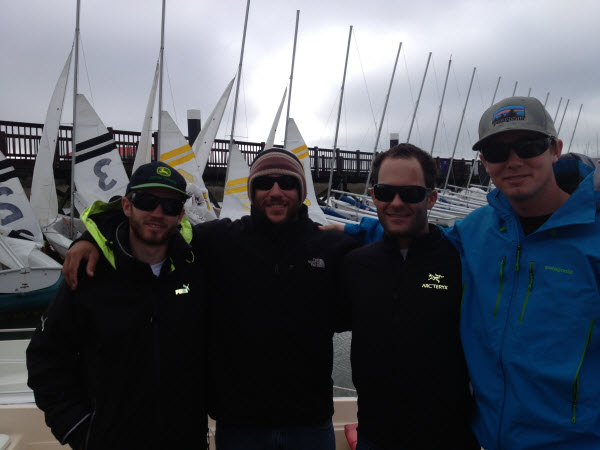


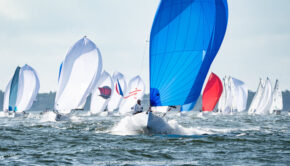
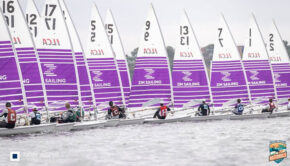
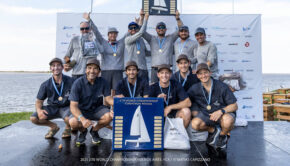
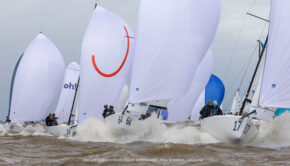
 We’ll keep your information safe.
We’ll keep your information safe.